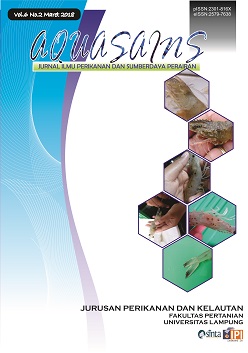THE CONTENT OF LEAD, CADMIUM, CUPRUM, AND ZINC IN ANCHOVY (Stolephorus SP) AND WHITE SHRIMPS (Penaeus merguensis) IN KAO BAY OF NORTH HALMAHERA
DOI:
https://doi.org/10.23960/aqs.v6i2.p597-604 Abstract View: 893
Abstract View: 893
Abstract
Some researcher’s claim some of fish have been studied in Kao Bay were at dangerous level because mercury and cyanide contains. Nevertheless, up to now people around Kao Bay were consumed a marine product as a livelihood sources and food sources. The purpose of this research were to determine of Pb,
Cd, Cu and Zn on anchovy (Stolephorus sp) and white shrimp (Penaeus marguiensis) around Kao Bay. The result expected could contributing
the feasible of anchovy and white shrimp were consumed. The method were used to determine the content of Pb, Cd, Cu and Zn on anchovy and white shrimp by using AAS method with HNO3 reagent. Those research assess the
content of heavy metals in laboratory of Mathematics and Science Faculty of Brawijaya University. The results obtained the metal content in anchovy were Zn> Cd> Pb> Cu and the metal content in white shrimp were Zn> Cu> Pb> Cd. The results showed the content of Pb, Cd, Cu and Zn on anchovies had exceeded the maximum limit were set and the content of Pb, Cd, and Cu on white shrimps has exceeded except the Zn in was below the maximum limit but is already at a critical level.

.png)










